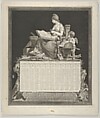Revolutionary Calendar
Louis Philibert Debucourt French
Not on view
Following the French Revolution, a Republican calendar was adopted and in use from 1793 to 1805. The religious and royalist references of the Gregorian calendar were purged and replaced with names drawn from nature. With a structure based on the decimal system, the new calendar began each year in the autumn.
Debucourt presents the calendar with the months and days of Year II (1793–94) inscribed in a box. The allegorical figure of Philosophy sits atop a stone outcropping amid various symbols of learning and the newly founded French Republic. Based on his own design, it is a tour de force of the aquatint technique, employing a full range of painterly tones, from white and pale grays through the inkiest blacks.
This image cannot be enlarged, viewed at full screen, or downloaded.


